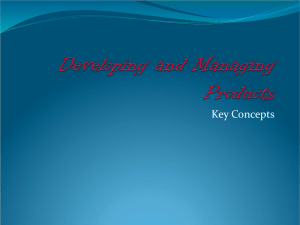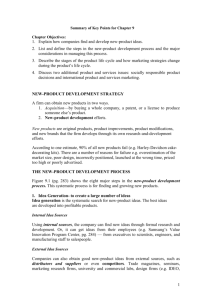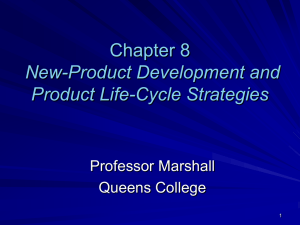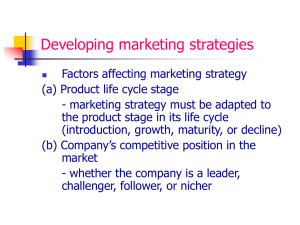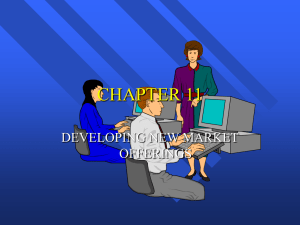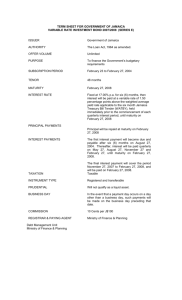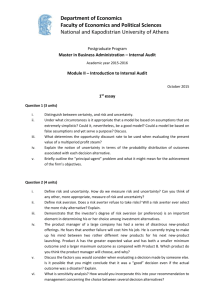CHAPTER 9
advertisement
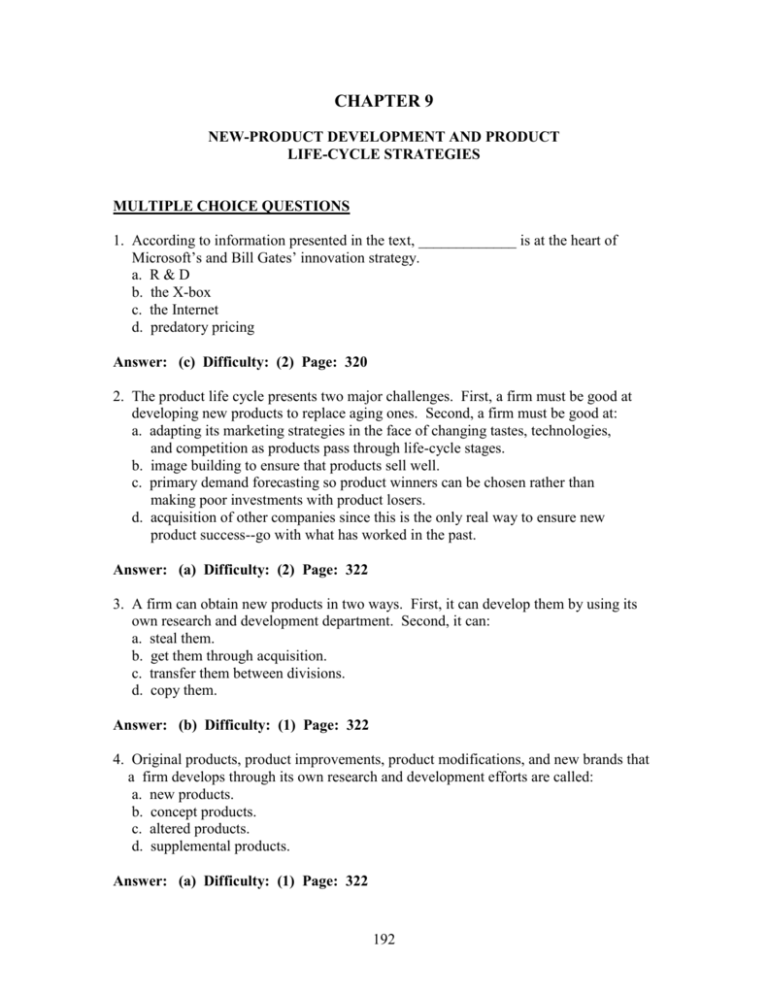
CHAPTER 9 NEW-PRODUCT DEVELOPMENT AND PRODUCT LIFE-CYCLE STRATEGIES MULTIPLE CHOICE QUESTIONS 1. According to information presented in the text, _____________ is at the heart of Microsoft’s and Bill Gates’ innovation strategy. a. R & D b. the X-box c. the Internet d. predatory pricing Answer: (c) Difficulty: (2) Page: 320 2. The product life cycle presents two major challenges. First, a firm must be good at developing new products to replace aging ones. Second, a firm must be good at: a. adapting its marketing strategies in the face of changing tastes, technologies, and competition as products pass through life-cycle stages. b. image building to ensure that products sell well. c. primary demand forecasting so product winners can be chosen rather than making poor investments with product losers. d. acquisition of other companies since this is the only real way to ensure new product success--go with what has worked in the past. Answer: (a) Difficulty: (2) Page: 322 3. A firm can obtain new products in two ways. First, it can develop them by using its own research and development department. Second, it can: a. steal them. b. get them through acquisition. c. transfer them between divisions. d. copy them. Answer: (b) Difficulty: (1) Page: 322 4. Original products, product improvements, product modifications, and new brands that a firm develops through its own research and development efforts are called: a. new products. b. concept products. c. altered products. d. supplemental products. Answer: (a) Difficulty: (1) Page: 322 192 5. New products continue to fail at a disturbing rate. One study estimated that new consumer packaged goods (consisting mostly of line extensions) fail at a rate of: a. 100 percent. b. 90 percent. c. 80 percent. d. 70 percent. Answer: (c) Difficulty: (3) Page: 322 6. Why do so many new products fail? All of the following are reasons EXCEPT: (Select the LEAST LIKELY reason.) a. the size of the market has been overestimated. b. hostility on the part of the sales force. c. the product may have been incorrectly positioned. d. a high-level executive might have pushed a favorite idea. Answer: (b) Difficulty: (3) Page: 322 7. If a new product has higher quality, new features, and higher value in use than its competition, then it is called a(n): a. unique superior product. b. synergistic product. c. positioned product. d. pre-launch product. Answer: (a) Difficulty: (2) Page: 323 8. Which of the following would be a key success factor in developing new products? a. a well-defined product concept b. a product priced well below market or industry standards c. a product that appeals to the late majority d. a product that can be sold over the Internet with a minimum of explanation Answer: (a) Difficulty: (2) Page: 323 9. To create successful new products, a company must understand consumers, markets, and competitors and: a. develop a great advertising campaign. b. have a strong Web site to push the product. c. adopt a push rather than pull promotional concept. d. develop products that deliver superior value to consumers. Answer: (d) Difficulty: (2) Page: 323 193 10. Which of the following best describes the first stage of the new-product development process? a. idea screening b. concept development and testing c. idea generation d. business analysis Answer: (c) Difficulty: (2) Page: 323, Figure 9-1 11. The systematic search for new-product ideas is characteristic of which stage in the new-product development process? a. idea screening b. concept development and testing c. idea generation d. business analysis Answer: (c) Difficulty: (2) Page: 323 12. After idea generation has occurred in the new-product development process, the next stage is most likely to be: a. ideation. b. idea screening. c. concept development and testing. d. test marketing. Answer: (b) Difficulty: (1) Page: 323, Figure 9-1, 328 13. For every 1,000 ideas, only _____ will have enough commercial promise to merit a small-scale experiment. a. 10 b. 50 c. 100 d. 300 Answer: (c) Difficulty: (3) Page: 323 14. According to the text, all of the following are thought to be sources of new-product ideas EXCEPT: a. internal sources. b. customers. c. competitors. d. the local library. Answer: (d) Difficulty: (1) Page: 323 194 15. According to “Mr. Failure’s Lessons for Sweet Success,” all of the following would help to prevent failure on the part of new products EXCEPT: a. offer real value. b. cherish thy brand. c. don’t be too different. d. always be the lowest priced. Answer: (d) Difficulty: (2) Page: 324, 325 16. The search for new-product ideas should be systematic rather than haphazard. One way to ensure that the process is systematic is to install a(n): a. product planning committee. b. venture capital team. c. idea management system. d. a Delphi idea system. Answer: (c) Difficulty: (2) Page: 327 17. If an organization wishes to create an innovation-oriented company culture, it should consider the ____________ approach. a. product planning approach b. venture capital team c. idea manager d. Delphi idea system Answer: (c) Difficulty: (2) Page: 327 18. ________________ is screening new-product ideas in order to spot good ideas and drop poor ones as soon as possible. a. Idea generation b. Concept development and testing c. Idea screening d. Brainstorming Answer: (c) Difficulty: (1) Page: 328 19. One reason that idea screening is a critical stage in the new-product development process is that: a. product-development costs rise greatly in later stages and the company only wants those products that can succeed. b. competitors can quickly steal ideas so the company wants only those ideas that can be protected with patents. c. international competition and markets demand that all ideas be culturally sensitive. d. the Federal government carefully monitors each company’s idea screening process to make sure no national security matters are at stake. 195 Answer: (a) Difficulty: (2) Page: 328 20. A _______________ is an idea for a possible product that the company can see itself offering to the market. a. product idea b. product image c. product concept d. product feature Answer: (a) Difficulty: (2) Page: 328 21. A ___________________ is a detailed version of the idea stated in meaningful consumer terms. a. product idea b. product image c. product concept d. product feature Answer: (c) Difficulty: (2) Page: 328 22. A ____________________ is the way consumers perceive an actual or potential product. a. product idea b. product image c. product concept d. product feature Answer: (b) Difficulty: (2) Page: 328 23. If Toyota describes one of its cars of the future as being “a moderately priced subcompact designed as a second family car to be used around town; the car is ideal for running errands and visiting friends,” then the company has just stated a potential new product in terms of a: a. product idea. b. product image. c. product concept. d. product feature. Answer: (c) Difficulty: (3) Page: 328 24. Presenting new-product ideas to consumers in symbolic or physical ways to measure their reactions occurs during which of the following stages? a. idea generation b. concept testing c. marketing strategy d. screening 196 Answer: (b) Difficulty: (2) Page: 329 25. If a kitchen cabinet designer wished to test design concepts with customers, the designer might wish to use a _______________ program that would show the consumer how his or her kitchen would look and work if remodeled with the company’s products. a. color chart b. cartoon figure chart c. virtual reality d. descriptive schematic Answer: (c) Difficulty: (1) Page: 329 26. Designing an initial marketing strategy for a new product based on the product concept is called: a. screening. b. business analysis. c. product development. d. marketing strategy development. Answer: (d) Difficulty: (1) Page: 330 27. The marketing strategy statement consists of three parts. All of the following would be among those parts EXCEPT: a. description of the production flow diagrams. b. description of the target market. c. the planning product positioning. d. the sales, market share, and profit goals for the first few years. Answer: (a) Difficulty: (2) Page: 330, 331 28. The stage in the new-product development process in which the anticipated sales, market share, and profit goals for the first few years are described is called: a. idea generation. b. marketing strategy development. c. business analysis. d. product development. Answer: (b) Difficulty: (2) Page: 330 197 29. Sanyo intends to capture a 5-percent share of the small radio market in three years. To achieve this, product quality will start high and be improved over time. Price will begin low but then be raised (competition permitting). An advertising budget of $300,000 will be rolled out over a three-year period. To successfully accomplish its long-run goals, Sanyo should construct and then adhere to a(n): a. image statement. b. marketing strategy statement. c. product development theory. d. demand-curve theorem. Answer: (b) Difficulty: (2) Page: 331 30. When a company reviews sales, costs, and profit projections for a new product to find out whether these factors satisfy the company’s objectives, they are in which of the following new-product development stages? a. concept development and testing b. commercialization c. business analysis d. marketing strategy development Answer: (c) Difficulty: (2) Page: 331 31. Looking at the sales history of similar products and surveying market opinion are tools used at which stage in the new-product development process? a. concept development and testing b. commercialization c. business analysis d. marketing strategy development Answer: (c) Difficulty: (2) Page: 331 32. A company is in the ______________ stage of the new-product development process when the company develops the product concept into a physical product in order to assure that the product idea can be turned into a workable product. a. product development b. commercialization c. marketing strategy d. business analysis Answer: (a) Difficulty: (2) Page: 331 198 33. R&D and engineering first produce the product concept into a physical product during which of the following stages of the new-product development process? a. concept development and testing b. marketing strategy c. business analysis d. product development Answer: (d) Difficulty: (1) Page: 331 34. One of the unique considerations during the product development phase of the new product development process is that the _______________ developed during this phase should have the required functional features and also convey the intended psychological characteristics so consumer testing can be beneficial and meaningful. a. program b. placebo c. prototype d. process Answer: (c) Difficulty: (2) Page: 332 35. Introducing a new product and marketing program to more realistic market settings following functional and consumer approval is carried out at which new-product development stage? a. idea generation b. screening c. marketing strategy d. test marketing Answer: (d) Difficulty: (2) Page: 332 36. If a company wishes to test its positioning strategy, advertising, distribution, pricing, branding and packaging, and budget levels, it can do so during which of the following stages of the new-product development process? a. commercialization b. test marketing c. product development d. marketing strategy development Answer: (b) Difficulty: (2) Page: 332 199 37. James Manufacturing would like to do test marketing on a new bicycle that it has just developed, however, cost is a serious consideration. James Manufacturing has just been approached by a firm called Simul-Shop that has offered to study the bicycle market using a unique approach that will only cost about $25,000. Which of the following innovative test marketing methods is James Manufacturing probably considering? a. virtual reality research b. sequential research c. simultaneous research d. starch testing Answer: (a) Difficulty: (2) Page: 334-335, Marketing at Work 9-2 38. Introducing the new product into the market takes place in which stage of the new product development process? a. commercialization b. test marketing c. marketing strategy d. product development Answer: (a) Difficulty: (1) Page: 333 39. The FIRST decision that must be reached by the company that is introducing a new product is: a. where to introduce. b. the distribution process. c. the timing of the introduction. d. the number of outlets to be included in the rollout. Answer: (c) Difficulty: (3) Page: 333 40. With respect to developing new products, if a company chooses to introduce its new products city-by-city and region-by-region, then the company is probably using which of the following methods for launching new products? a. blitz b. blanket c. market rollout d. market blister Answer: (c) Difficulty: (1) Page: 333 200 41. When Colgate-Palmolive uses a ________________ strategy, they pick certain countries for new-product introductions before general introduction to entire regions or continents. a. gray market b. primo country c. demand-based d. lead-country Answer: (d) Difficulty: (2) Page: 333 42. A new-product development approach in which one company department works to complete its stage of the process before passing the new product along to the next department and stage is called: a. sequential product development. b. retrograde product development. c. simultaneous product development. d. reactive product development. Answer: (a) Difficulty: (3) Page: 336 43. Overlapping steps in the new-product development process to save time and increase effectiveness across the various departments involved is called: a. sequential product development. b. retrograde product development. c. simultaneous product development. d. reactive product development. Answer: (c) Difficulty: (3) Page: 336 44. The simultaneous approach to new-product introduction does have several limitations. All of the following would be considered to be among those limitations EXCEPT: a. it is riskier than other forms of introduction. b. it is more costly in many instances. c. it is too slow for many marketers. d. it has increased organizational tension and confusion. Answer: (c) Difficulty: (3) Page: 336 45. The course of a product’s sales and profits over its lifetime is called: a. the sales chart. b. the dynamic growth curve. c. the adoption cycle. d. the product life cycle. Answer: (d) Difficulty: (1) Page: 337 201 46. The ______________ is characterized by five distinct stages: product development, introduction, growth, maturity, and decline. a. adoption cycle b. fashion process c. product life cycle d. style curve Answer: (c) Difficulty: (1) Page: 337, 338 47. With respect to the product life cycle, the _____________ begins when the company finds and develops a new-product idea. a. product development stage b. introduction stage c. growth stage d. maturity stage Answer: (a) Difficulty: (1) Page: 337, Figure 9-2 48. With respect to the product life cycle, the ______________ is a period of slow sales growth as the product is introduced in the market. a. product development stage b. introduction stage c. growth stage d. maturity stage Answer: (b) Difficulty: (1) Page: 337, Figure 9-2 49. With respect to the product life cycle, the _______________ is a period of rapid market acceptance and increasing profits. a. product development stage b. introduction stage c. growth stage d. maturity stage Answer: (c) Difficulty: (1) Page: 337, Figure 9-2 50. With respect to the product life cycle, the ________________ is a period of slowdown in sales growth because the product has achieved acceptance by most potential buyers. a. product development stage b. introduction stage c. growth stage d. maturity stage Answer: (d) Difficulty: (1) Page: 337, Figure 9-2 202 51. With respect to the product life cycle, the __________________ is the period when sales fall off and profits drop. a. decline stage b. introduction stage c. growth stage d. maturity stage Answer: (a) Difficulty: (1) Page: 337, Figure 9-2 52. The product life cycle concept has many varied uses. The PLC can describe all of the following EXCEPT: a. a product class. b. a product form. c. a product shape. d. a product brand. Answer: (c) Difficulty: (2) Page: 338 53. ______________ have the longest product life cycles. a. Product forms b. Product brands c. Product genres d. Product classes Answer: (d) Difficulty: (2) Page: 338 54. In terms of special product life cycles, a _____________ is a basic and distinctive mode of expression. a. genre b. style c. fashion d. fad Answer: (b) Difficulty: (2) Page: 338 55. In terms of special product life cycles, a _______________ would be exemplified by the “preppie look” in the clothing of the late 1970s and early 1980s. a. genre b. style c. fashion d. fad Answer: (c) Difficulty: (2) Page: 338 203 56. In terms of special product life cycles, a _________________ only lasts for a short time, is adopted with a great deal of zeal, peaks early, and declines very fast. a. genre b. style c. fashion d. fad Answer: (d) Difficulty: (1) Page: 338 57. “Pet rocks” are a classic example of which of the following? a. a genre b. a style c. a fashion d. a fad Answer: (d) Difficulty: (2) Page: 338, 339 58. Which of the following is characterized by a extremely peaked demand curve that rises rapidly and declines rapidly in a short period of time? a. a genre b. a style c. a fashion d. a fad Answer: (d) Difficulty: (2) Page: 339, Figure 9-3 59. A concentration on producing a basic version of a product by a firm and its competitors is typical of which stage in the product life cycle? a. product development stage b. introduction stage c. growth stage d. maturity stage Answer: (b) Difficulty: (2) Page: 339, 345, Table 9-2 60. An increase in competition, attracted by the opportunities for profit, is typical of which stage of the product life cycle? a. decline stage b. introduction stage c. growth stage d. maturity stage Answer: (c) Difficulty: (2) Page: 340, 345, Table 9-2 204 61. In the ___________ , a firm faces a trade-off between high market share and high current profit. a. decline stage b. introduction stage c. growth stage d. maturity stage Answer: (c) Difficulty: (2) Page: 340, 345, Table 9-2 62. The stage of the PLC characterized by overcapacity, greater competition, and the eventual elimination of weaker competitors is called the: a. decline stage. b. introduction stage. c. growth stage. d. maturity stage. Answer: (d) Difficulty: (2) Page: 340, 345, Table 9-2 63. In the maturity phase of the PLC, a marketing manager should consider: a. dropping the product and moving on to the next product winner. b. modifying the market, product, and marketing mix. c. expanding R & D. d. pricing to penetrate the market. Answer: (b) Difficulty: (3) Page: 340, 345, Table 9-2 64. The strategy used during maturity to attempt to increase the consumption of the current product is called: a. customer modification. b. market modification. c. product modification. d. marketing mix modification. Answer: (b) Difficulty: (2) Page: 340 65. All of the following are examples of products that have had very long and successful product life cycles EXCEPT: a. Beanie Babies. b. Barbie. c. the Plymouth Prowler. d. Crayola Crayons. Answer: (c) Difficulty: (1) Page: 341, 342, Marketing at Work 9-3 205 66. Cutting prices, using aggressive sales promotion, or launching a better advertising campaign, are all typical elements of which strategy used during the maturity stages of the PLC? a. customer modification b. market modification c. product modification d. marketing mix modification Answer: (d) Difficulty: (2) Page: 343 67. Technological advances, shifts in consumer tastes, and increased competition, all of which reduce demand for a product, are typical of which stage in the PLC? a. decline stage b. introduction stage c. growth stage d. maturity stage Answer: (a) Difficulty: (2) Page: 343, 345, Table 9-2 68. As a product reaches its decline stage of the PLC, management may decide to __________ the product, which means reducing various costs and hoping that sales hold up. a. disengage b. drop c. harvest d. cultivate Answer: (c) Difficulty: (1) Page: 344 69. The stage in the product life cycle that focuses on using a cost-plus formula and creating product awareness and trial is the: a. decline stage. b. introduction stage. c. growth stage. d. maturity stage. Answer: (b) Difficulty: (2) Page: 345, Table 9-2 70. The stage in the product life cycle where the strategic focus is on market penetration and building intensive distribution is the: a. decline stage. b. introduction stage. c. growth stage. d. maturity stage. Answer: (c) Difficulty: (2) Page: 345, Table 9-2 206 71. The stage in the product life cycle where the strategic focus is on maximizing profit while defending market share and pricing to match or best the competition is called the: a. decline stage. b. introduction stage. c. growth stage. d. maturity stage. Answer: (d) Difficulty: (2) Page: 345, Table 9-2 72. The stage in the product life cycle where the strategic focus is on reducing expenditures and milking the brand while cutting prices is called the: a. decline stage. b. introduction stage. c. growth stage. d. maturity stage. Answer: (a) Difficulty: (2) Page: 345, Table 9-2 TRUE/FALSE QUESTIONS 73. One of the challenges presented by the product life cycle for a product is that of new-product development. Answer: (True) Difficulty: (1) Page: 322 74. Today, innovation can be very risky. Answer: (True) Difficulty: (1) Page: 322 75. One study has estimated that a much as 80 percent of new consumer goods and new products fail. Answer: (True) Difficulty: (2) Page: 322 76. Most new products that fail in the consumer goods category are called line extensions. Answer: (True) Difficulty: (1) Page: 322 77. One study found that the number one success factor for new-product introduction is a unique, superior product. Answer: (True) Difficulty: (2) Page: 323 207 78. Idea screening is generally recognized to be the first step in the new-product development process. Answer: (False) Difficulty: (2) Page: 323, Figure 9-1 79. 3M’s well-known “15-percent rule” states that all employees receive a 15-percent bonus (no matter their salary) for every new-product idea they produce. Answer: (False) Difficulty: (2) Page: 323 80. The purpose of idea screening is to generate a large number of ideas from which new products will be drawn. Answer: (False) Difficulty: (1) Page: 323, 330 81. According to Mr. Failure’s Lessons for Sweet Success, cherish thy brand is a secret to success. Answer: (True) Difficulty: (2) Page: 324, 325 82. The search for new-product ideas works best if it is haphazard because of the unique ways in which crazy ideas often produce the best new products. Answer: (False) Difficulty: (1) Page: 327 83. A product concept is the way that consumers perceive an actual or potential product. Answer: (False) Difficulty: (2) Page: 328 84. Virtual reality is now being used to test product concepts. Answer: (True) Difficulty: (1) Page: 329 85. The marketing strategy statement consists of three parts: a description of the target market; the planned product positioning; and the sales, market share, and profit goals for the first few years. Answer: (True) Difficulty: (2) Page: 330, 331 86. All products should be test marketed. Answer: (False) Difficulty: (2) Page: 332 208 87. The amount of test marketing needed for new products remains constant and varies little between product styles, fashions, and fads. Answer: (False) Difficulty: (1) Page: 332 88. A company launching a new product must first decide on introduction budget. Answer: (False) Difficulty: (2) Page: 333 89. Under a sequential product development approach, one company department works individually to complete its stage of the development process before passing the new product along to the next department and stage. Answer: (True) Difficulty: (2) Page: 335, 336 90. Under a simultaneous product development approach, one company department works individually to complete its stage of the development process before passing the new product along to the next department and stage. Answer: (False) Difficulty: (2) Page: 335, 336 91. In terms of the PLC, the growth stage is a period of rapid market acceptance and increasing profits. Answer: (True) Difficulty: (1) Page: 337 92. A minivan would be a good example of a product form. Answer: (True) Difficulty: (2) Page: 338 93. Fads tend to grow slowly, remain popular for a while, and then decline slowly. Answer: (False) Difficulty: (2) Page: 338 94. If a company were to change characteristics of the product such as quality, features, or style, it would most likely do this in the maturity phase of the product life cycle. Answer: (True) Difficulty: (2) Page: 340 95. If a company chose to harvest from its product life cycle, this would most likely occur in the growth phase of the product life cycle. Answer: (False) Difficulty: (2) Page: 344 209 96. In the growth stage of the PLC, cost-plus pricing is used. Answer: (False) Difficulty: (3) Page: 345, Table 9-2 97. Selective distribution is a characteristic of the introduction stage of the PLC. Answer: (True) Difficulty: (2) Page: 345, Table 9-2 98. Reducing the expenditures and milking the brand become marketing objectives during the maturity stage of the product life cycle. Answer: (False) Difficulty: (2) Page: 345, Table 9-2 99. Middle majority customers buy during the maturity stage of the product life cycle. Answer: (True) Difficulty: (2) Page: 345, Table 9-2 ESSAY QUESTIONS 100. No matter what brand of computer you’re using or what you’re doing on it, you’re almost certain to be using some type of Microsoft product or service. Is Microsoft known as an innovator? Explain. What is at the heart of Microsoft’s innovation strategy? List and briefly discuss three of Microsoft’s new innovations as described in the text. Answer: According to information provided by the chapter, new-product success at Microsoft starts with a companywide culture that supports innovation. Whereas many companies try to protect their successful current products, Microsoft encourages innovations. Microsoft has not always been viewed as an innovator. In the past they have been accused of being a copycat or actually stealing technology. Thanks to a large cash fund Microsoft can now innovate on its own. At the heart of its new innovation strategy is the Internet. Gates wants to be wherever the consumer is and currently that is on the Web. To complete this question, students can discuss any of the seven new products that Microsoft plans to introduce in the next several years. Some of these, such as the X-box, are already on the market. Difficulty: (2) Page: 319-322 210 101. Why do so many new products fail? What can be done to increase the likelihood that the new product will be successful? Answer: New products continue to fail at an alarming rate. There are several reasons for high failure rates. Although an idea may be good, the market size may have been overestimated. Perhaps the actual product was not designed as well as it should have been. Or maybe it was incorrectly positioned in the market, priced too high, or advertised poorly. A high-level executive might push a favorite idea despite poor marketing research findings. Sometimes the costs of product development are higher than expected and sometimes competitors fight back harder than expected. Success chances can be enhanced if the new product is a unique, superior product; has a well-defined product concept; if the company understands its customers, markets, and competitors; and develops products that delivery superior value to consumers. Difficulty: (2) Page: 322, 323 102. List and briefly define the stages of the new-product development process. Answer: The new-product development process has eight stages: (a) Idea generation--the systematic search for new ideas. (b) Idea screening--screening new-product ideas in order to spot good ideas and drop poor ones as soon as possible. (c) Concept development and testing--a product idea, product concept, and product image are developed and then tested. (d) Marketing strategy development--designing initial marketing strategy for a new product based on the product concept. (e) Business analysis--a review of the sales, costs, and profits projections for a new product to find out whether these factors satisfy the company’s objectives. (f) Product development--a strategy for company growth by offering modified or new products to current market segments. (g) Test marketing--the product and marketing program are tested in more realistic market settings. (h) Commercialization--introducing a new product into the market. Difficulty: (3) Page: 323-337, Figure 9-1 211 103. List and briefly discuss the sources of new-product ideas. Answer: The major sources of new-product ideas include internal sources, customers, competitors, distributors and suppliers, and others. (a) Many new-product ideas come from internal sources. The company can find new ideas through formal research and development. It can pick the brains of its executives, scientists, engineers, and manufacturing people. It can also use its sales force (who are in daily contact with customers). (b) Good new-product ideas come from watching and listening to customers. The company can analyze customer questions and complaints to find new products that better solve consumer problems. The company can meet with customers to get suggestions and to learn about needs and wants. Often, customers create their own unique products to solve their problems--companies can benefit by learning about these. (c) Competitors are another good source of new-product ideas. Watch ads and commercials to get clues about new-product entries. The company can also reverse engineer a competitor’s products to learn about how they are made and about strengths and weaknesses. (d) Distributors and suppliers contribute many good new-product ideas. These resellers often see consumer needs first hand and ask their suppliers to make products for customers. Suppliers can tell the company about new concepts, techniques, and materials that can be used to develop new products. (e) Other sources include: trade magazines, shows, and seminars; government agencies; new-product consultants; advertising agencies; marketing research firms; university and commercial laboratories; and inventors. Difficulty: (2) Page: 323-327 104. According to Mr. Failure’s Lessons for Sweet Success, what lessons should a marketer learn to avoid failure. List and briefly discuss each of the lessons. Answer: Lessons include: (a) Offer real value--many classic flops failed to deliver what customers really wanted. (b) Cherish thy brand--the value of a brand is its good name, which it earns over time. (c) Be different--me-too marketing is the number-one killer of new products. (d) But don’t be too different--products often fail because customers don’t or can’t relate to them. (e) Accentuate the positive--people don’t buy products that remind them of their shortcomings. Difficulty: (2) Page: 324, 325, Marketing at Work 9-1 212 105. Distinguish among a product idea, concept, and image. Answer: (a) A product idea is an idea for a possible product that the company can see itself offering to the market. (b) A product concept is a detailed version of the idea stated in meaningful consumer terms. (c) A product image is the way consumers perceive an actual or potential product. Difficulty: (1) Page: 328 106. The marketing strategy statement consists of three parts. What are they? Briefly, illustrate each. Answer: The three parts are: (a) Description of the target market. (b) The planned product positioning. (c) The sales, market share, and profit goals for the first few years. See the chapter material for illustrations of each part. Difficulty: (1) Page: 330, 331 107. Distinguish between sequential product development and simultaneous product development. Relate the advantages and disadvantages of each form. Answer: Sequential product development--a new-product development approach in which one company department works to complete its stage of the process before passing the new product along to the next department and stage. Known to be orderly but slow. Poor in a rapidly changing market where speed is important. Simultaneous (or team-based) product development--an approach to developing new products in which various company departments work closely together, overlapping the steps in the product-development process to save time and increase effectiveness. Good for speed, however, it can be riskier and more costly. It also creates organization tension and confusion. Difficulty: (2) Page: 335, 336 213 108. Identify and briefly characterize the five stages of the product life cycle. Answer: (a) Product development--begins when the company finds and develops a new-product idea. During product development, sales are zero and the company’s investment costs mount. (b) Introduction--a period of slow sales growth as the product is introduced in the market. Profits are nonexistent in this stage because of the heavy expenses of product introduction. (c) Growth--a period of rapid market acceptance and increasing profits. (d) Maturity--a period of slowdown in sales growth because the product has achieved acceptance by most potential buyers. Profits level off or decline because of increased marketing outlays to defend the product against competition. (e) Decline--the period when sales fall off and profits drop. Difficulty: (3) Page: 337-345, Figure 9-2, Table 9-2 109. Characterize the differences between styles, fashions, and fads with respect to the PLC concept. Answer: A style is a basic and distinctive mode of expression. It may last for several generations. A fashion is a currently accepted or popular style in a given field. Fashions tend to grow slowly, remain popular for a while, and then slowly decline. A fad is a fashion that enters quickly, is adopted with great zeal, peaks early, and declines very rapidly. Difficulty: (2) Page: 338, 339, Figure 9-3 110. Characterize the strategies that are available for marketers in the maturity phase of the PLC. Give an illustration along with your characterization. Answer: There are three possible strategy scenarios. (a) Modifying the market--the company tries to increase the consumption of the current product by finding new users, new market segments, and increased usage among existing customers. The company can also reposition the product. (b) Modifying the product--changing the characteristics of the product such as features, quality, style to attract new users and to inspire more usage. (c) Modifying the marketing mix--improving sales by changing one or more marketing mix elements. Cutting prices, changing distributors, or modifying promotion are common techniques. Difficulty: (2) Page: 340, 342, 343 214 111. Taking the stages of introduction, growth, maturity, and decline found in the product life cycle, briefly discuss the strategies that might be used in product, price, distribution, and advertising to guide the product through the life cycle. Answer: (a) In the introduction stage, offer a basic product, use cost-plus pricing, build selective distribution, and build product awareness among early adopters and dealers. (b) In the growth stage, offer product extensions, service, and warranty; price to penetrate the market; build intensive distribution; and build awareness and interest in the mass market. (c) In the maturity stage, diversify the brand and models, price to match or best competition, build more intensive distribution, and stress brand differences and benefits in advertising. (d) In the decline stage, phase out weak products, cut price, go selective in distribution outlets and phase out unprofitable outlets, and reduce the level needed to retain hardcore loyal consumers. Difficulty: (3) Page: 345, Table 9-2 APPLICATION QUESTION 112. Gibson Guitar company was in trouble. Gibson, perceived to be a high-quality but expensive electric guitar company (with models from $1,300 to $4,400), was losing market share to rival Fender Guitar company. Fender had expensive models in its prestigious Stratocaster line but had recently established a budget line (models for the beginning guitar player) under the brand name Squire by Fender. The Squire models began at $150 and ranged to $350. Research showed that players who began with Squire often upgraded to Stratocasters as they gained experience and interest. Gibson now has the opportunity to purchase Epiphone Guitar company and use their line of low- to midprice guitars ($300-$700) to counter Fender’s strategy for first-time guitar players. Your job as marketing executive for Gibson is to recommend a new-product strategy for Gibson. Consider which phases of the new-product development process would apply and suggest a course of action for Gibson. Be sure to explain your decision. Answer: As indicated in the text, a company can often grow by developing new products. Sometimes this occurs through acquisition rather than development. In this case, Gibson would be faced with the decision as to whether to acquire the Epiphone line or develop a line of lower priced guitars to meet Fender’s challenge and seeming strength with the first-time guitar buyer. Gibson should realize that brand loyalty begins early with the guitar player. The company should also realize that its high-quality but expensive line is not for the first-time user. Students can approach this creative situation from several directions. First, they can agree to buy Epiphone. If they do, they should then propose a method for integrating the line into Gibson’s line. The student should then address distribution, pricing, and advertising issues. Table 9-2 will give some indication of what 215 these strategies might be since the Epiphone line should be considered to be in its maturity phase. Second, the student can reject Epiphone and consider developing a Gibson line of inexpensive guitars. If this direction is chosen, then the student should go through a simulation of the new-product development process as suggested in the chapter. Attention should be paid to any problem of potential cannibalization. Lastly, the student could decide to reject entry into the budget market by Gibson. If this alternative is chosen, the student should justify their suggestion that the budget market is not for Gibson. The instructor may wish to give additional instructions with this short mini-case application question, give it as an in-home assignment, or ask the students to do additional research to answer the question. The company eventually decided to acquire the Epiphone line. However, a good case could be made for developing an independent budget line themselves. The only poor answer would be to ignore the situation. The instructor should grade this question based on a student’s ability to creatively think and use chapter information rather than usage of specific lists or definitions. Try it, you will be surprised how creative some students can be with this issue. Difficulty: (3) Page: 323, Figure 9-1, 345, Table 9-2 216
